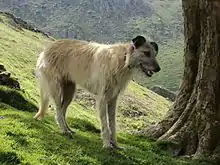Lurcher
The lurcher is a mixed-breed dog, specifically a sighthound mated with another dog type, most commonly a herding dog or a terrier. Historically a poacher's dog, lurchers in modern times are kept as pets, hunting dogs and in racing.
| Lurcher | |||||||||||||||||||||
|---|---|---|---|---|---|---|---|---|---|---|---|---|---|---|---|---|---|---|---|---|---|
 Longhaired Lurcher | |||||||||||||||||||||
| Origin | Great Britain and Ireland | ||||||||||||||||||||
| |||||||||||||||||||||
| Dog (domestic dog) | |||||||||||||||||||||
Description
A lurcher is generally a cross between a sighthound and a working dog breed.[1] Generally, the aim of the cross is to produce a sighthound with more intelligence, a canny animal suitable for poaching rabbits, hares and game birds. Over time, poachers and hunters discovered that the crossing of certain breeds with sighthounds produced a dog better suited to this purpose, given the lurcher's combination of speed and intelligence.
Etymology
The word 'lurcher' comes from Middle English lurch, to lurk or remain in a place furtively.[2] The archaic English meaning of the word lurcher is a prowler, swindler, or petty thief.[2] The origin of the word may be in the French lacher, to move suddenly to one side.[3]
History
The distinction in England between a greyhound and a lurcher was both legal and biological. Greyhounds were used to hunt legally only by the privileged upper class who could show qualification by sufficient income or estate. Anyone else with a lower income was, from 1389, prohibited from hunting with any hound whatsoever, including a lurcher.[4]
Brian Plummer identifies the Norfolk Lurcher as the predecessor of the modern lurcher.[5][6]
Modern roles
The modern lurcher is regarded as an exceptional family dog. Many groups have been founded to re-home lurchers as family pets.[7]
Lurchers excel at sports such as lure coursing and dog racing, which are popular in areas with little available hunting or with people who dislike hunting. In the USA, lurchers are eligible to compete in lure coursing events sanctioned by the National Lure Coursing Club.[8]
Recognition and registration
Because lurchers are not purebreds they are not recognized by any of the major kennel clubs although the acronym HJCK serves in some circles: Hunt Jump Catch Kill. However, the North American Lurcher and Longdog Association was created in 2007 to serve as a registering body for lurchers and longdogs in the United States and Canada.[9]
See also
References
- Blount, Deborah (February 2000). "The Lurcher Submission for the Committee of Inquiry into Hunting with Dogs in England and Wales". The Association of Lurcher Clubs. Archived from the original on 23 January 2013. Retrieved 1 February 2015.
- "Lurcher". Oxford Dictionaries UK Dictionary. Oxford University Press. Retrieved 1 February 2015.
- "Lurch". Online Etymology Dictionary. Retrieved 7 August 2020.
- "AD 1389 Cap. XIII". Statutes at large. Retrieved 7 August 2020.
- Rogues and Running Dogs David Brian Plummer, 1976 Tabard Press
- Plummer, Brian (1979). The Complete Lurcher. The Boydell Press. ISBN 9780851151182.
- Drakeford, J. (2003). The House Lurcher. Shrewsbury: Swan Hill Press. ISBN 978-1-904057-34-5.
- Lure Coursing Club
- "Lure Coursing, Amateur Whippet & Sighthound Racing - NALLA Overview". Lure Coursing, Amateur Whippet & Sighthound Racing. Retrieved 2015-12-21.
External links
- Houndsfirst Sighthound Rescue operating within the UK.
- GRWE (Greyhound rescue West of England)Greyhound and Lurcher rescue
- Greyhound Rescue Wales (Greyhound and Lurcher rescue)
- House Lurchers, a website for all non-working Lurchers
- Lurchers
- Lurcher Link, discussion forum and lurcher rescue
- Evesham Greyhound and Lurcher Rescue
- Greyhound Gap - greyhound and lurcher rescue operating in the UK
- Lurcher Racing in Hailsham, Sussex, UK
- Association of Working Lurchers / Longdogs